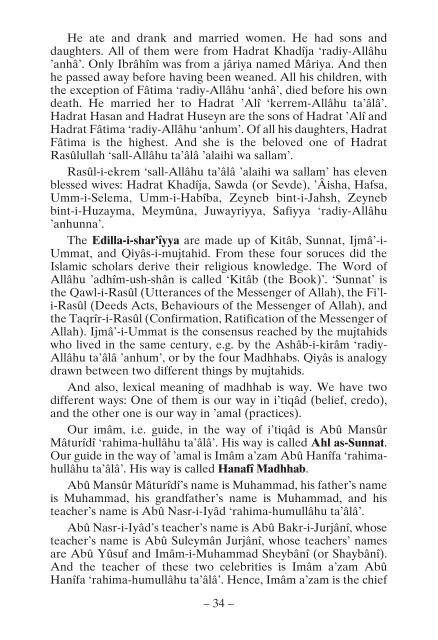Miftah-ul-Janna (Booklet for way to Paradise)
You also want an ePaper? Increase the reach of your titles
YUMPU automatically turns print PDFs into web optimized ePapers that Google loves.
He ate and drank and married women. He had sons and<br />
daughters. All of them were from Hadrat Khadîja ‘radiy-Allâhu<br />
’anhâ’. Only Ibrâhîm was from a jâriya named Mâriya. And then<br />
he passed a<strong>way</strong> be<strong>for</strong>e having been weaned. All his children, with<br />
the exception of Fâtima ‘radiy-Allâhu ‘anhâ’, died be<strong>for</strong>e his own<br />
death. He married her <strong>to</strong> Hadrat ’Alî ‘kerrem-Allâhu ta’âlâ’.<br />
Hadrat Hasan and Hadrat Huseyn are the sons of Hadrat ’Alî and<br />
Hadrat Fâtima ‘radiy-Allâhu ‘anhum’. Of all his daughters, Hadrat<br />
Fâtima is the highest. And she is the beloved one of Hadrat<br />
Rasûl<strong>ul</strong>lah ‘sall-Allâhu ta’âlâ ’alaihi wa sallam’.<br />
Rasûl-i-ekrem ‘sall-Allâhu ta’âlâ ’alaihi wa sallam’ has eleven<br />
blessed wives: Hadrat Khadîja, Sawda (or Sevde), ’Âisha, Hafsa,<br />
Umm-i-Selema, Umm-i-Habîba, Zeyneb bint-i-Jahsh, Zeyneb<br />
bint-i-Huzayma, Meymûna, Ju<strong>way</strong>riyya, Safiyya ‘radiy-Allâhu<br />
’anhunna’.<br />
The Edilla-i-shar’îyya are made up of Kitâb, Sunnat, Ijmâ’-i-<br />
Ummat, and Qiyâs-i-mujtahid. From these four soruces did the<br />
Islamic scholars derive their religious knowledge. The Word of<br />
Allâhu ’adhîm-ush-shân is called ‘Kitâb (the Book)’. ‘Sunnat’ is<br />
the Qawl-i-Rasûl (Utterances of the Messenger of Allah), the Fi’li-Rasûl<br />
(Deeds Acts, Behaviours of the Messenger of Allah), and<br />
the Taqrîr-i-Rasûl (Confirmation, Ratification of the Messenger of<br />
Allah). Ijmâ’-i-Ummat is the consensus reached by the mujtahids<br />
who lived in the same century, e.g. by the Ashâb-i-kirâm ‘radiy-<br />
Allâhu ta’âlâ ’anhum’, or by the four Madhhabs. Qiyâs is analogy<br />
drawn between two different things by mujtahids.<br />
And also, lexical meaning of madhhab is <strong>way</strong>. We have two<br />
different <strong>way</strong>s: One of them is our <strong>way</strong> in i’tiqâd (belief, credo),<br />
and the other one is our <strong>way</strong> in ’amal (practices).<br />
Our imâm, i.e. guide, in the <strong>way</strong> of i’tiqâd is Abû Mansûr<br />
Mâturîdî ‘rahima-h<strong>ul</strong>lâhu ta’âlâ’. His <strong>way</strong> is called Ahl as-Sunnat.<br />
Our guide in the <strong>way</strong> of ’amal is Imâm a’zam Abû Hanîfa ‘rahimah<strong>ul</strong>lâhu<br />
ta’âlâ’. His <strong>way</strong> is called Hanafî Madhhab.<br />
Abû Mansûr Mâturîdî’s name is Muhammad, his father’s name<br />
is Muhammad, his grandfather’s name is Muhammad, and his<br />
teacher’s name is Abû Nasr-i-Iyâd ‘rahima-hum<strong>ul</strong>lâhu ta’âlâ’.<br />
Abû Nasr-i-Iyâd’s teacher’s name is Abû Bakr-i-Jurjânî, whose<br />
teacher’s name is Abû S<strong>ul</strong>eymân Jurjânî, whose teachers’ names<br />
are Abû Yûsuf and Imâm-i-Muhammad Sheybânî (or Shaybânî).<br />
And the teacher of these two celebrities is Imâm a’zam Abû<br />
Hanîfa ‘rahima-hum<strong>ul</strong>lâhu ta’âlâ’. Hence, Imâm a’zam is the chief<br />
– 34 –

















